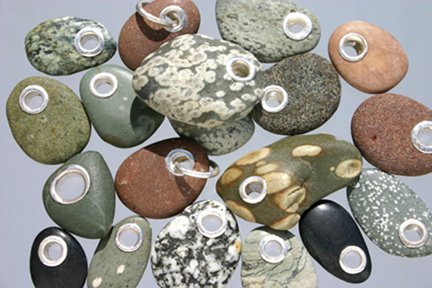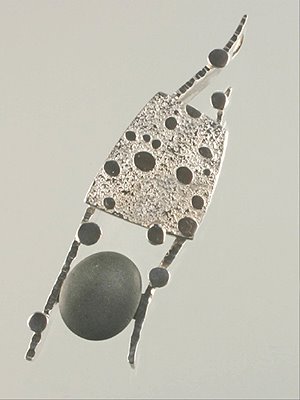Mokume Gane is a Japanese term that
roughly translates to mean “wood-grain in metal”. It was always
one of those ancient mysteries of the orient. Primarily it was a
metal billet formed from layers of metals that varied greatly in
color. These billets were then shaped and deformed to bring out
brilliant patterns on the surface. This metal technique was seen
mostly in the furnishings of samurai swords. These uses included
handles, guards and the sheaths of these weapons. Mokume Gane was
highly secretive process that was passed on from artisan to artisan
in an oral tradition.
The process of forming these multilayer
billets predated technology and as such the process was controlled
and duplicated by religious constraints. The temperatures were often
regulated by the colors of a rising sun and the timing by the length
of a chant or song. Oral traditions are easily broken as the number
of participants dwindle. By the beginning of the twentieth century
the secrets of Mokume Gane were thought to have passed beyond recall.
Fast forward to the rise of “Metal
Arts” in American colleges and Art schools during the late sixties
and early seventies. During this time period there was a wide
spread attempt to reproduce the look of Mokume Gane using modern
techniques. Many artisans used layers of different colored metals
soldered together with silver solder to mimic the ancient art form.
The results these efforts produced were very limiting, superficial
and mostly unsatisfactory. There were wide spread rumors in the
metal art world of individuals that wanted to make excursions into
the orient to interview the old artisans of the knife guilds to try
to glean some of the old ways. It was a hope that this information
might result in a translation of the old oral tradition into modern
metallurgy. It is not the scope of this article to explore who went
where and discovered what. It is a fact however, that today one can
obtain information that will result in a very satisfactory Mokume
Gane billet regardless of how close it adheres to the materials of
the seventeenth century. I bring your attention to the materials,
publications, classes and lectures of such metal artists as Steve Midgett, James Binnion and the metal wizard I have watched closely,
Phillip Baldwin.
Speaking of “Phillips” my client
Philip wanted us to make a cuff for him that would turn heads and
start conversations. He wanted something classy but still with a lot
of eye appeal. I thought that Mokume Gane would be just the thing.
I have always admired subtle things like fine Irish linen, where the
closer you look the more there is to see. Sometimes you have to just
sit back and let the material do the talking.
The cuff form itself was shaped in a
hydraulic press with tooling that I made myself using magnets and
mild steel. There was a lot of experimenting using copper and brass
blanks to get the shapes and lengths just right. It was more than
once I nearly gave my finger a good pinch in the press. But after a
bit of time, some patience and a bunch of tweaking the project
started to come around. My hydraulic press is an old “Bonny Doon”
from years ago. We don't use it as much as we should and sometimes
we even forget that it's in that far dark corner of the studio just
under the breaker panel.
My plan was to keep this piece fairly
simple and rely on the materials and “glyph” to do the heavy
lifting. This is the Mokume Gane cuff that I made for him with the ever
present band “glyph” on top.






No comments:
Post a Comment